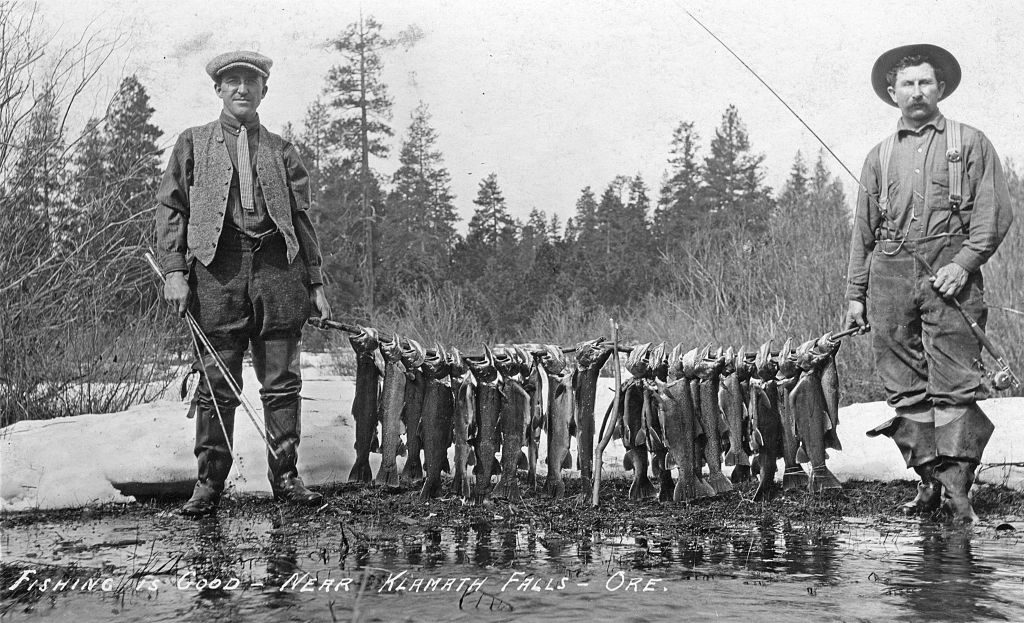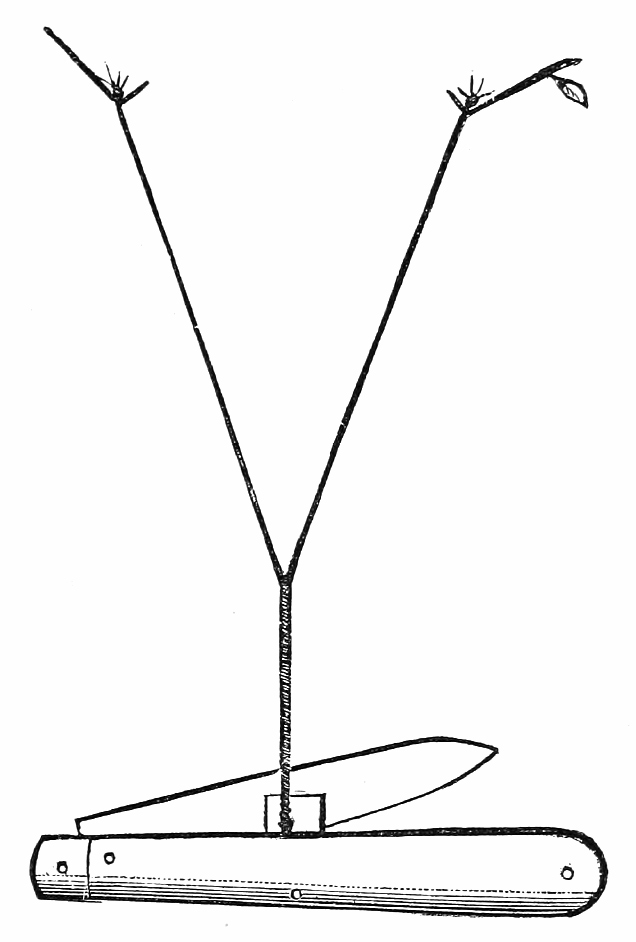
For those of you that have access to a horse who doesn’t mind a few hairs being snipped (a mare won’t work) this tip on how to make a horse-hair fish line may come in handy. I found it in “Practical hints on camping.” By Howard Henderson. 1882
THE HORSE-HAIR FISH LINE.
One of the chief delights of the lover of out-of-door life is to be independent, and able to shift for himself. The real sportsman should know at least how every article he uses is made, if he cannot make it; and there is no small satisfaction in being your own manufacturer, whenever it is practicable. As a pure horse-hair line is not easily to be found in the market, and possesses many advantages, we give here full directions for making one. There is sometimes found a combined silk and hair line, but these lines have not proven satisfactory. Either use a pure silk or a pure hair line. The horse-hair line is very light, strong and durable. It will not rot like the silk line. Frequently it will be found that it can be used effectually where other lines have failed to show a single nibble. If you wish a line light in color, and almost transparent, use white hairs only, and with age the line will improve in tone. A dark line to resemble the fine roots and dead grasses always to be found in streams, should be made of reddish or brown hair, with a few black hairs interwoven. Remember it is a horse-hair line. Use hairs from the tail of a horse only, not from a mare. The latter are too weak and brittle. The size of a line depends upon the use it is to be put to, the rule is, one hair will sustain a pound of dead weight; but allowance must be made for sudden strains or jerks, and therefore extra hairs are required. A fine trout line can be made from nine hairs, and will be strong enough for all ordinary fishing.
Before commencing your line, wash the hair in tepid water, using a little soap. This not only cleans the hair, but makes it softer and more pliable. Next dry thoroughly, and see that the hairs lie nicely together. Then fold them in a newspaper, leaving the large ends out a trifle, so as to be easily picked up.
There are three ways of making a horse-hair line:
First method of making a horse-hair fish line
Take three spools of ordinary size. Whittle off one end of each, leaving the end slightly tapering, but not so thin as to split too easily. Cut three round smooth pegs that fit nicely into the holes of the spools, leaving one end of the peg square, and larger than the round part, so as to form a head which can be easily taken hold of. The whole peg is about half an inch long. For a trout line take nine hairs, which may be of unequal length, but for a first experiment had better be pretty long. Lay the large or coarse ends evenly together, and tie a knot at the extreme end. Tie another knot half an inch below the first. You require a good steady purchase, and for this purpose attach your hair, between the two knots, to a hook or nail driven into a tree or your tent pole. Divide your hair into three strands, running each strand through one of the spools, so that the small end of the spool will be toward the knots. Slip your spools up within a couple of inches of the second knot, and insert your pegs tightly at either end of the spool to keep the hairs in their place, and to prevent the spool from slipping. Hold the line, which remains attached to the hook, between the thumb and forefinger of the left hand. Take up one of the spools with the right hand, and twist the strand toward the right. Then lay it over the other strands, and hold it in position by placing it under the left thumb. Take another spool, twist in the same way, always to the right. Lay that strand over the other two, holding the two last in position with the thumb. Repeat the same thing with the last spool.
You now have the three spools in position. To avoid confusion mark them 1, 2 and 3, commencing with the right hand spool. Take up the right hand spool, No. 1, letting the next one, No. 2. drop; it will take care of itself. Give the strand two or three turns, and lay it over strand No. 3, which is still held in position between the left forefinger and thumb.
Hold it there and pick up spool No. 2, letting No. 3 drop, and give it two or three twists and lay the strand over No. 1, holding it there. Pick up No. 3 and repeat the same thing, and thus go on. In a few moments you will see the beginning of a neat round line, one of the most finished lines you ever handled, providing you have done your work right. The operation is very simple. Twist always to the right, and lay over to the left.
Loosen your pegs and slip down your spools as occasion requires, but do not allow too much distance between your spools and the line you are making. The shorter the distance the tighter and more compact your line will be. There is such a thing, however, as making it too compact and unyielding. Do not twist so much as to kink your strands. A little practice and your own judgment will enable you to know what length is required. The line can be made any length, and only careful inspection will show where the hairs join.
To add a fresh hair you have merely to take out the peg and run the coarse or large end of the hair through the spool close along the strand, and about half an inch beyond the main strand or line. Insert the peg. Place the fresh hair under the line just where the three strands unite; it is held in place by thus being between the line and the left forefinger. Now give the spool several turns, and go on as before. As a rule you need pay no attention to the end of the hair just running out. It will shortly work itself to one side. Always add the fresh hairs to the strand that is to be laid over next. To prevent confusion, and to preserve even thickness of line, do not add two or three hairs all at once, and for this reason the hairs should be of unequal length. When your line is completed you will have a large number of short ends sticking out on all sides. Fasten your line to something firm above you and suspend by it a slight weight so as to stretch the line a little, but not strain it. Take a sharp knife and neatly cut off the ends close to the line. You can cut on the thumb nail. Use the greatest of care to avoid injuring the line itself.
The diagram is sufficient to explain how this line is made:

In the place of spools small sticks can be used. Take a green branch about as large around as the forefinger. Cut three pieces from it from five to six inches long. Split them half way up with your knife, and insert your hairs in the split. Work these sticks the same way you would the spools.
Second method of making a horse-hair fish line
A second method of making a line is to proceed exactly in the way last described, except that instead of laying the strands over each other, you simply make the ordinary three-strand plait. This will give you instead of a round line a flat line. It looks well, is serviceable, and can be made much quicker, but is by no means equal in strength or finish to the other.
third method of making a horse-hair fish line
Another method is as follows: To make a line, say of eight hairs, pull out from your paper the required number. See that they are of about equal length and have them all run the same way, that is the larger ends, or roots, all together. Place the large ends together, and tie a single knot at the extreme end of the strand. Now tie another knot half an inch lower down. Separate your eight hairs into two strands of four hairs each, and tie a knot at the end of each strand. Next cut from the neighboring bush (for we will suppose you are in camp waiting for the rain to stop) two small forked twigs. Trim them, and cut off from each, one of the branches about half an inch from the fork, and cut the other branch four or five inches above the fork. You now have two small hooks with the shank about five inches in length. Insert your hooks or twigs, one in each strand of your line, just under the knots at the ends. You must have a weight at the other end, and you will probably find your pocket knife the most convenient article at hand. Open the large blade part way, fold a piece of paper over the edge to prevent its cutting the hair, and then close it down upon the line between the first and second knots. Pick up your twigs, one in each hand, and turn them slowly with the fingers, being careful that you turn them in opposite directions, say the right hand one from you, the left hand one toward you. Raise the arms so as to let the knife be suspended in the air, and its weight will keep the strands straight. In a moment the knife will commence to revolve, and your separate strands will twist together. By holding the twigs or hooks well apart, the line will be more compact. When finished take off your twigs and make another piece in the same way. Tie the pieces together by a neat, strong knot, and thus keep on to any desired length.
This is the most expeditious way of making a horsehair line, but it is somewhat objectionable on account of the number of knots, which, especially with a reel, would be inconvenient.
The following diagram explains the whole process.
